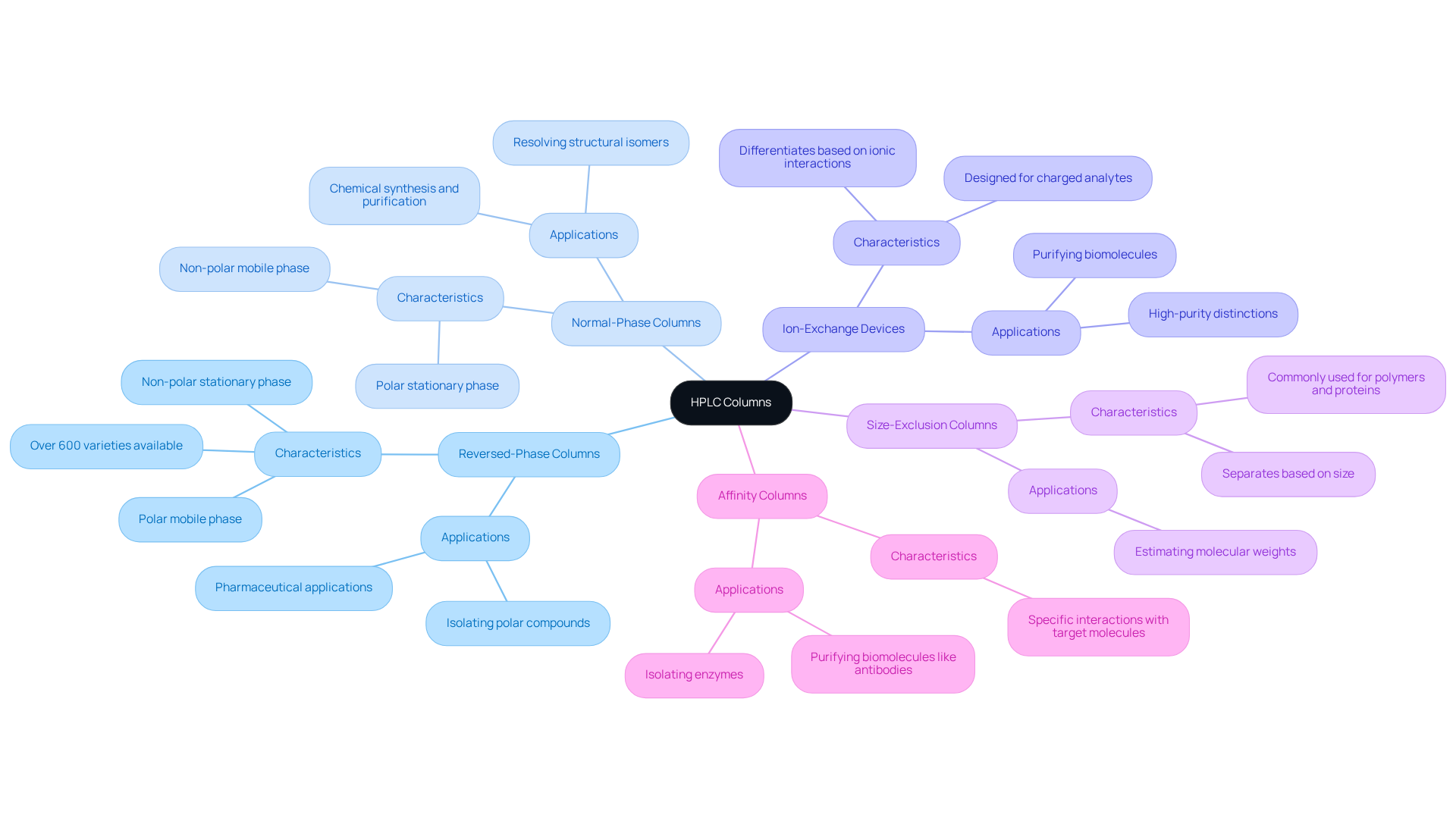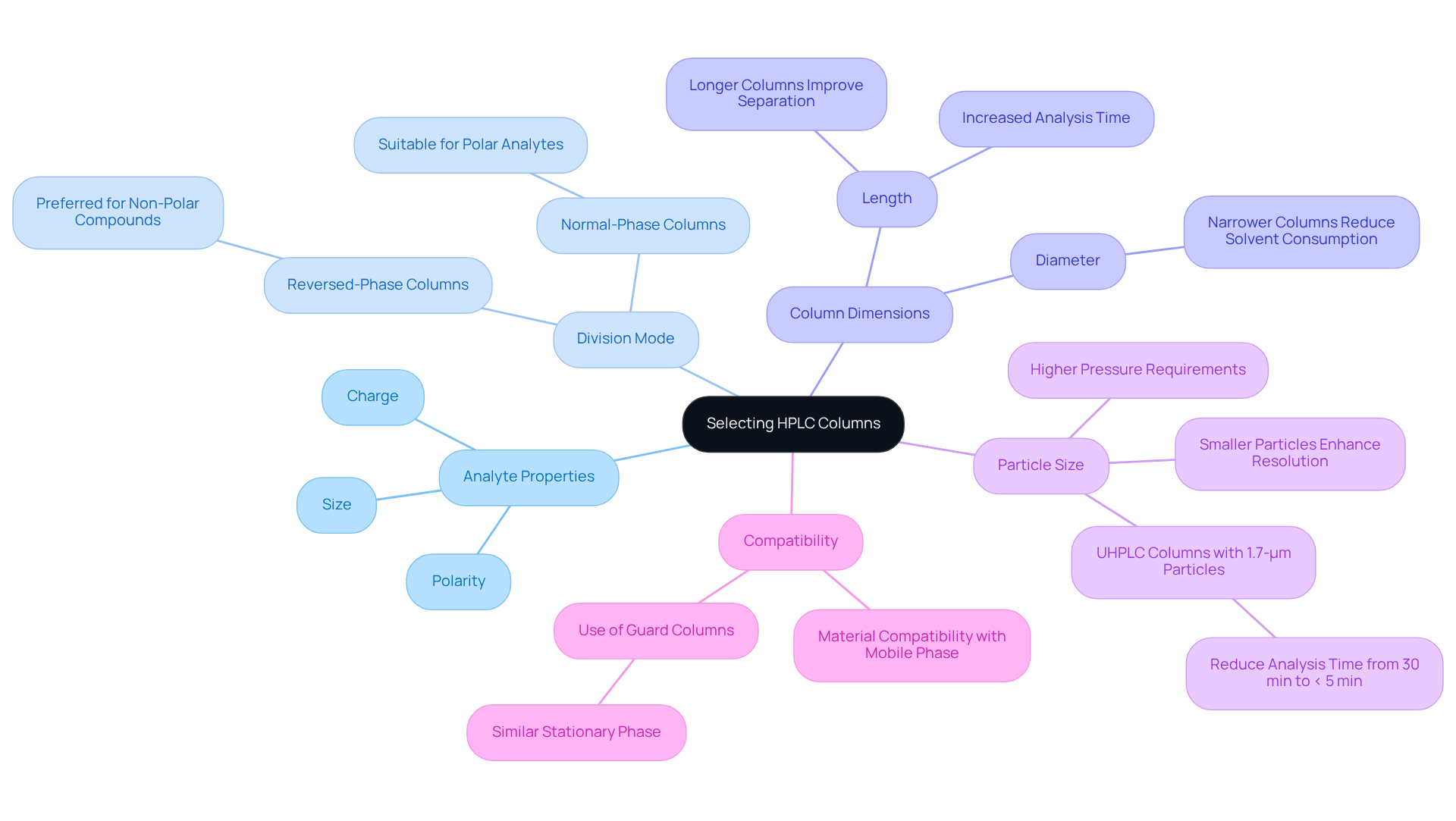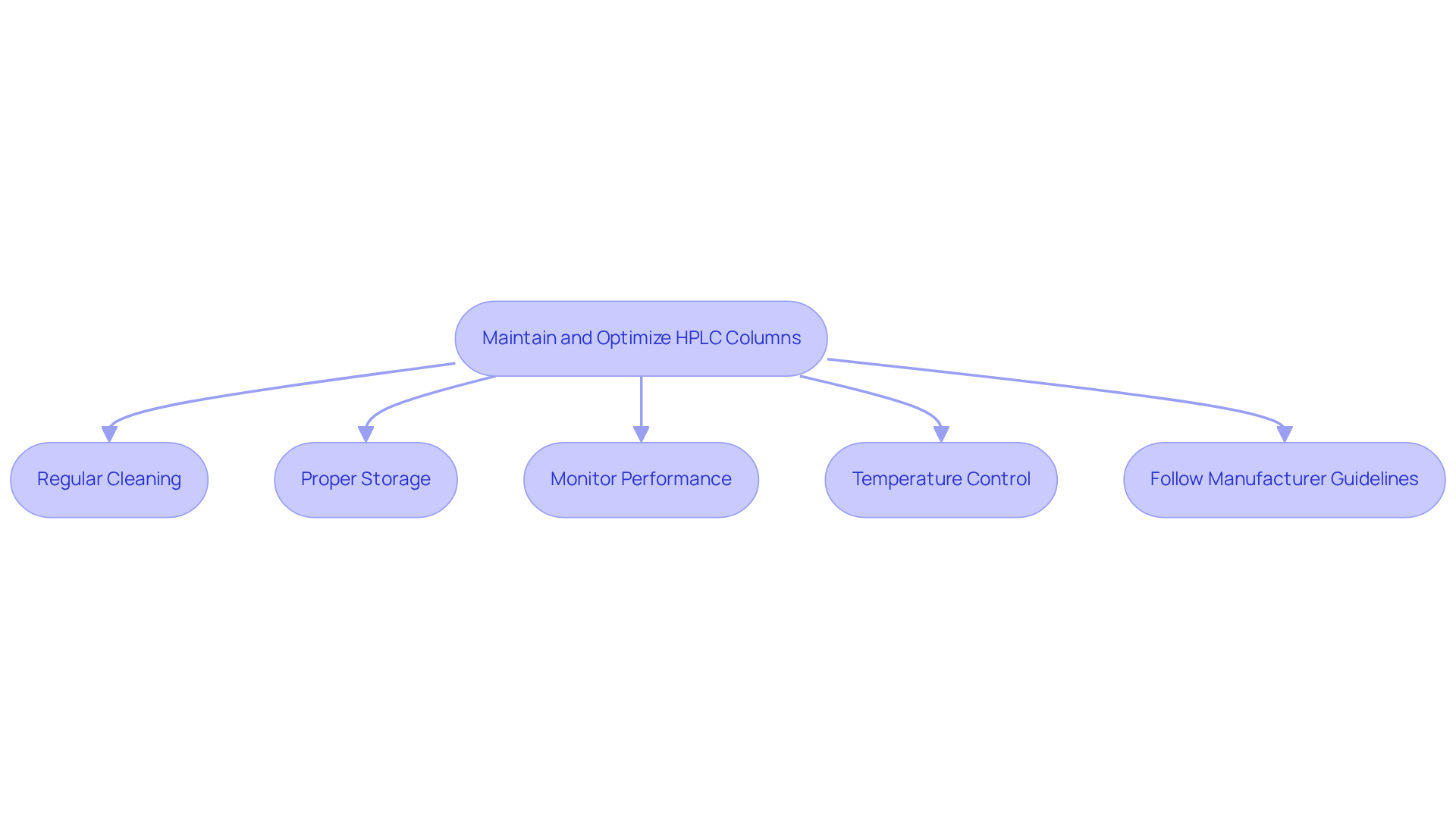Overview
This article serves as a crucial guide for lab managers tasked with selecting the appropriate High-Performance Liquid Chromatography (HPLC) columns. It meticulously details the various types of columns available and their respective applications, underscoring the significance of understanding analyte properties, column dimensions, and maintenance practices. Such knowledge is essential for optimizing analytical processes and ensuring accurate results across diverse laboratory settings. By doing so, it enhances overall efficiency and upholds data integrity, ultimately leading to improved laboratory outcomes.
Introduction
High-Performance Liquid Chromatography (HPLC) is a cornerstone of analytical chemistry, facilitating the separation and quantification of complex mixtures with exceptional precision. For lab managers, mastering the various types of HPLC columns is not merely beneficial; it is essential for optimizing workflows and achieving reliable results across a range of applications, from pharmaceuticals to environmental testing. Yet, with a multitude of column options available, how can one ascertain the best fit for specific analytical needs? This article explores the intricacies of HPLC types, providing valuable insights and practical guidance on column selection, maintenance, and optimization to enhance laboratory efficiency and accuracy.
Explore the Fundamentals of High-Performance Liquid Chromatography (HPLC)
High-Performance Liquid Chromatography (HPLC) types are sophisticated analytical techniques integral to the distinction, identification, and quantification of components within complex mixtures. This procedure utilizes a mobile medium, typically a solvent, to transport the sample through a stationary medium, which consists of a tube filled with specific materials. The separation of analytes occurs due to their unique interactions with the stationary phase, influenced by factors such as polarity, size, and charge. For laboratory managers, a comprehensive understanding of these fundamentals is essential for optimizing analytical processes and ensuring precise results across diverse applications, including pharmaceuticals, environmental testing, and food safety.
Key components of HPLC include:
- Mobile Phase: The solvent that carries the sample through the column, vital for effective separation.
- Stationary Phase: The substance inside the tube that interacts with the analytes, affecting partitioning efficiency.
- Pump: Delivers the mobile phase at high pressures, facilitating the separation process.
- Detector: Monitors the elution of compounds as they exit the column, generating data for analysis. Advanced detectors, such as Osaka Soda's NQAD, enhance the accuracy of analytical results by providing highly selective detection features, making them indispensable in liquid chromatography applications.
Industry leaders emphasize the importance of understanding HPLC types for laboratory managers, noting that proficiency in the mobile and stationary components of these HPLC types significantly enhances . Real-world examples illustrate how optimizing these phases leads to improved separation and quantification in laboratory environments. For instance, the integration of advanced detectors with high-performance liquid chromatography has proven to bolster the accuracy of analytical outcomes, reinforcing the method's critical role in maintaining high standards in pharmaceutical quality assurance and research. Additionally, the average particle size in high-performance liquid chromatography systems, typically ranging from 1.5 to 50 μm, is a crucial consideration for lab managers when selecting such systems. As HPLC types continue to advance, staying informed about their fundamentals and developments is vital for lab managers striving to enhance efficiency and accuracy in their operations.

Identify Different Types of HPLC Columns and Their Applications
HPLC types can be classified according to their stationary substance chemistry and the type of separation they facilitate. Understanding these categories is crucial for lab managers aiming to ensure optimal sample analysis and separation. Here are the main types:
- Reversed-Phase Columns: This is the most frequently utilized type, featuring a non-polar stationary medium (e.g., C18) paired with a polar mobile medium. These columns are ideal for isolating polar compounds, with available on the market. This abundance provides lab managers with a wide range of options. The solvophobic theory indicates that retention in RP-HPLC is influenced by hydrophobic interactions with the hydro-organic mobile medium, underscoring the significance of these systems in pharmaceutical applications.
- Normal-Phase Columns: These employ a polar stationary medium and a non-polar mobile medium, making them suitable for isolating non-polar compounds. They are particularly effective in resolving structural isomers and are frequently used in chemical synthesis and purification processes.
- Ion-Exchange Devices: Designed for charged analytes, these structures differentiate based on ionic interactions, making them ideal for purifying biomolecules such as proteins and nucleic acids. This capability facilitates high-purity distinctions, which are crucial in biotechnology and biochemistry.
- Size-Exclusion Columns: These separate molecules based on size and are commonly used for polymers and proteins. They operate without competing mechanisms, allowing larger molecules to pass through while retaining smaller ones. This feature is vital for estimating molecular weights.
- Affinity Columns: These utilize specific interactions between the stationary phase and target molecules, often applied in biochemical contexts for purifying and isolating biomolecules like antibodies and enzymes.
Grasping these HPLC types and their applications is essential for lab managers to ensure optimal separation and analysis of their samples. The choice between reversed-phase and normal-phase materials can significantly influence the efficiency and precision of analytical outcomes. Reversed-phase options are the most frequently utilized due to their versatility and effectiveness across various applications. Furthermore, narrower-bore tubes, such as 2.1 mm ID, enhance sensitivity and reduce solvent expenses, while guard tubes are recommended to prolong the lifespan of costly high-performance liquid chromatography tubes. As the field evolves, staying informed about the latest advancements and expert recommendations will enhance laboratory operations and outcomes.

Select the Right HPLC Column: Key Considerations and Best Practices
When selecting , lab managers must consider several key factors to ensure optimal performance and reliable results.
- Analyte Properties: Understanding the chemical characteristics of the analytes, including polarity, size, and charge, is crucial for selecting the appropriate type of support. Among the various HPLC types, reversed-phase columns are generally preferred for non-polar or weakly polar compounds, whereas normal-phase columns are more suitable for polar analytes.
- The choice of division mode—whether among the different HPLC types like reversed-phase or normal-phase—should align with specific application requirements. This decision significantly impacts the efficiency and effectiveness of the division process.
- Column Dimensions: Choosing the correct length and diameter is vital for balancing resolution and analysis time. Longer columns typically yield improved separation but can substantially extend run times. For example, transitioning to narrower columns can lead to an 80% reduction in solvent consumption during continuous operation, enhancing both efficiency and sustainability. As David S. Bell notes, "Switching to these smaller structures leads to an 80% decrease in solvent consumption for continuous 24-hour operation."
- Particle Size: The size of the particles within the column plays a pivotal role in resolution. Smaller particles can enhance resolution but may require higher pressure. Utilizing different HPLC types, including ultra-high performance liquid chromatography (UHPLC) columns with 1.7-µm particles, can reduce analysis time from 30 minutes to less than 5 minutes, resulting in significant solvent savings.
- Compatibility: Ensuring that the material used for the column is compatible with the mobile phase and analytes is essential to avoid degradation or contamination. For instance, employing a guard column with a similar stationary phase to the main column can optimize compatibility and safeguard the primary column from impurities. This practice is crucial for maintaining the integrity of the analysis and ensuring consistent results.
By adhering to these best practices, lab managers can substantially enhance their chromatography methods, leading to improved accuracy and reliability in analytical results. As stated by Chromasir, "For professional advice on high-performance liquid chromatography optimization, reach out to Chromasir—we focus on delivering tailored chromatography solutions to assist your laboratory in attaining the utmost standards of performance.

Maintain and Optimize HPLC Columns for Reliable Performance
To maintain and optimize HPLC columns, lab managers must implement best practices that ensure reliability and accuracy in laboratory operations.
- Regular Cleaning is essential. Flush tubes with 20-30 mL of a 40/60 methanol/water solution to effectively remove contaminants and prevent blockages. Additionally, flush with the initial mobile phase for 5-10 volumes at the end of each batch or shift to uphold the system's integrity.
- Proper Storage is equally critical. Store sections in at least 30% organic solvent, such as methanol or acetonitrile, to prevent degradation and microbial growth. It is vital to avoid long-term storage in buffered solutions, as this can lead to corrosion and solid deposits that compromise performance.
- Monitor Performance regularly. Track , including pressure, retention times, and peak shapes. Systematic monitoring aids in identifying early warning signs before structures fail mid-study. A retention time shift exceeding 2% may indicate issues with mobile medium pH or the integrity of the tube, necessitating urgent attention.
- Temperature Control cannot be overlooked. Maintain a consistent temperature during operation, ideally avoiding rapid changes. A maximum temperature ramp of nearly 5 °C/min is recommended to prevent cracking of the packed bed and thermal degradation of the stationary phase, ensuring reproducibility in results.
- Follow Manufacturer Guidelines meticulously. Adhere to the manufacturer's recommendations for usage, maintenance, and storage. This includes logging, flushing, and storage activities utilizing a straightforward log template to optimize performance and longevity.
By implementing these maintenance strategies, lab managers can significantly enhance the reliability and accuracy of their HPLC types, ultimately leading to improved data integrity and smoother lab operations.

Conclusion
High-Performance Liquid Chromatography (HPLC) is a cornerstone in analytical chemistry, facilitating precise separation, identification, and quantification of complex mixtures. For lab managers, mastering the various types of HPLC columns and their specific applications is essential to optimize laboratory efficiency and achieve accurate results. This expertise not only aids in selecting the appropriate column type but also enhances overall analytical processes across diverse sectors, from pharmaceuticals to environmental testing.
The article explores the different categories of HPLC columns, including:
- Reversed-phase
- Normal-phase
- Ion-exchange
- Size-exclusion
- Affinity columns
Each type serves distinct purposes based on the properties of the analytes and the desired separation outcomes. Key considerations for column selection—such as analyte characteristics, column dimensions, and maintenance practices—are emphasized to ensure reliable performance. Additionally, best practices in maintaining HPLC columns are outlined, underscoring the importance of regular cleaning, proper storage, and consistent monitoring to sustain optimal functionality.
In summary, the understanding of HPLC types and their applications is paramount for lab managers who seek to enhance their analytical capabilities. Staying informed about the latest advancements and adhering to best practices in column selection and maintenance will lead to improved accuracy, efficiency, and sustainability in laboratory operations. Embracing these insights empowers laboratories to achieve the highest standards of performance, ultimately contributing to advancements in research and quality assurance across various industries.




